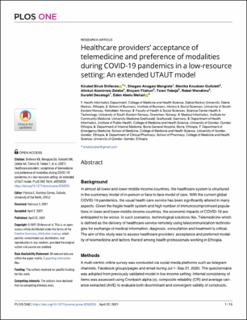| dc.contributor.author | Shiferaw, Kirubel Biruk | |
| dc.contributor.author | Mengiste, Shegaw Anagaw | |
| dc.contributor.author | Gullslett, Monika Knudsen | |
| dc.contributor.author | Zeleke, Atinkut Alamirrew | |
| dc.contributor.author | Tilahun, Binyam | |
| dc.contributor.author | Tebeje, Tsion | |
| dc.contributor.author | Wondimu, Robel | |
| dc.contributor.author | Desalegn, Surafel | |
| dc.contributor.author | Mehari, Eden Abetu | |
| dc.date.accessioned | 2022-03-25T14:17:41Z | |
| dc.date.available | 2022-03-25T14:17:41Z | |
| dc.date.created | 2021-06-23T12:53:40Z | |
| dc.date.issued | 2021 | |
| dc.identifier.citation | Shiferaw, K. B., Mengiste, S. A., Gullslett, M. K., Zeleke, A. A., Tilahun, B., Tebeje, T., Wondimu, R., Desalegn, S. & Mehari, E. A. (2021). Healthcare providers’ acceptance of telemedicine and preference of modalities during COVID-19 pandemics in a low-resource setting: An extended UTAUT model. PLoS One, 16(4), Artikkel e0250220. | en_US |
| dc.identifier.issn | 1932-6203 | |
| dc.identifier.uri | https://hdl.handle.net/11250/2987716 | |
| dc.description.abstract | Background: In almost all lower and lower middle-income countries, the healthcare system is structured in the customary model of in-person or face to face model of care. With the current global COVID-19 pandemics, the usual health care service has been significantly altered in many aspects. Given the fragile health system and high number of immunocompromised populations in lower and lower-middle income countries, the economic impacts of COVID-19 are anticipated to be worse. In such scenarios, technological solutions like, Telemedicine which is defined as the delivery of healthcare service remotely using telecommunication technologies for exchange of medical information, diagnosis, consultation and treatment is critical. The aim of this study was to assess healthcare providers’ acceptance and preferred modality of telemedicine and factors thereof among health professionals working in Ethiopia.
Methods: A multi-centric online survey was conducted via social media platforms such as telegram channels, Facebook groups/pages and email during Jul 1- Sep 21, 2020. The questionnaire was adopted from previously validated model in low income setting. Internal consistency of items was assessed using Cronbach alpha (α), composite reliability (CR) and average variance extracted (AVE) to evaluate both discriminant and convergent validity of constructs. The extent of relationship among variables were evaluated by Structural equation modeling (SEM) using SPSS Amos version 23.
Results: From the expected 423 responses, 319 (75.4%) participants responded to the survey questionnaire during the data collection period. The majority of participants were male (78.1%), age <30 (76.8%) and had less than five years of work experience (78.1%). The structural model result confirmed the hypothesis “self-efficacy has a significant positive effect on effort expectancy” with a standardized coefficient estimate (β) of 0.76 and p-value <0.001. The result also indicated that self-efficacy, effort expectancy, performance expectancy, facilitating conditions and social influence have a significant direct effect on user’s attitude toward using telemedicine. User’s behavioral intention to use telemedicine was also influenced by effort expectancy and attitude. The model also ruled out that performance expectancy, facilitating conditions and social influence does not directly influence user’s intention to use telemedicine. The squared multiple correlations (r2) value indicated that 57.1% of the variance in attitude toward using telemedicine and 63.6% of the variance in behavioral intention to use telemedicine is explained by the current structural model.
Conclusion: This study found that effort expectancy and attitude were significantly predictors of healthcare professionals’ acceptance of telemedicine. Attitude toward using telemedicine systems was also highly influenced by performance expectancy, self-efficacy and facilitating conditions. effort expectancy and attitude were also significant mediators in predicting users’ acceptance of telemedicine. In addition, mHealth approach was the most preferred modality of telemedicine and this opens an opportunity to integrate telemedicine systems in the health system during and post pandemic health services in low-income countries. | en_US |
| dc.language.iso | eng | en_US |
| dc.rights | Navngivelse 4.0 Internasjonal | * |
| dc.rights.uri | http://creativecommons.org/licenses/by/4.0/deed.no | * |
| dc.title | Healthcare providers’ acceptance of telemedicine and preference of modalities during COVID-19 pandemics in a low-resource setting: An extended UTAUT model | en_US |
| dc.type | Journal article | en_US |
| dc.type | Peer reviewed | en_US |
| dc.description.version | publishedVersion | en_US |
| dc.rights.holder | © 2021 Shiferaw et al. | en_US |
| dc.source.volume | 16 | en_US |
| dc.source.journal | PLOS ONE | en_US |
| dc.source.issue | 4 | en_US |
| dc.identifier.doi | https://doi.org/10.1371/journal.pone.0250220 | |
| dc.identifier.cristin | 1917923 | |
| dc.source.articlenumber | e0250220 | en_US |
| cristin.ispublished | true | |
| cristin.fulltext | original | |
| cristin.qualitycode | 1 | |

